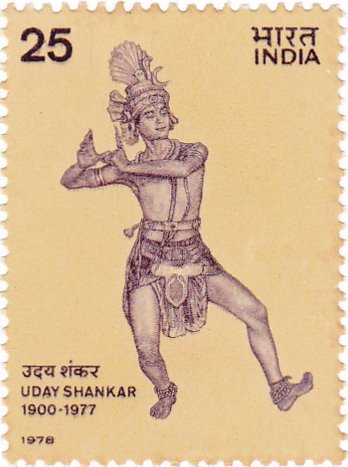
Uday Shankar
‐
Dancer and choreographer
Place of birth
Date of arrival to Britain
Place of death
Calcutta, India
Date of time spent in Britain
1920–5
About
Uday Shankar was an artist, dancer and choreographer who popularized Indian dance through his effective use of western theatrical techniques in combination with classical Indian dance. Uday Shankar arrived in London in 1920 to study art at the Royal College of Art under the tutelage of William Rothenstein. Rothenstein sent him to the British Museum to study the reproductions of paintings from the caves of Ajanta and Ellora. The Russian ballerina Ana Pavlova convinced Shankar to turn to dance, winning a fiercely fought battle with Rothenstein over the future artistic direction of Shankar. His performances with Pavlova, partnering her in the Krishna and Radha ballet and A Hindu Wedding in her programme titled Oriental Impressions, caused a sensation when first performed at the Royal Opera House, Covent Garden in September 1923 and they toured extensively through Europe and the US. Shankar returned to London in 1923 and struggled to make a living by trying to find engagements in London cabaret clubs. In 1925 he moved to Paris, where he had more success. In 1926 he was joined by the French dancer Simkie, whom he taught classical Indian dance and who joined him on subsequent tours of Europe.
Shankar returned to India in 1927 and toured all the major cultural centres in India to fire his imagination. At that time he also met Rabindranath Tagore. In 1930 he formed a new troupe of dancers and with a new programme returned to Paris in 1931 and subsequently toured with the programme to London and other major European cities. These performances in the early 1930s had a huge impact on art lovers in particular and led to a rediscovery of the cultural heritage of India. Shankar returned to India in 1935 and then toured Europe from 1936 to 1938 with a new troupe, which included the dancers Shanti Bardhan, Simkie, Zohra Sehgal and Uzra, once again taking all the big European cities by storm. During this time the troupe performed a charity performance at the Hindustani Social Club in London. In 1939 Shankar established the Uday Shankar India Culture Centre at Almora, India, which continued until 1943 – it had to be closed down because of the impact of the Second World War and financial difficulties. From 1943 to 1947 Shankar worked on the dance film Kalpana, which was widely acclaimed and which he personally presented in Europe, the USSR and the US in 1948. He went on a two-year tour of Europe and the US in 1949–50 to raise funds for a new dance school in Calcutta. He died in Calcutta in 1977.
Krishna Menon, Firoz Khan Noon, Ana Pavlova, William Rothenstein, Simkie, Rabindranath Tagore.
S. Hurok Presents Uday Shan-Kar and His Hindu Ballet (New York City: Nicolas Pub. Co., 1938)
Banerji, Projesh, Dance of India (Allahabad: Kitabistan, 1942)
Banerji, Projesh, Uday Shankar and His Art (Delhi: B. R. Publications, 1982)
Ghosh, Dibyendu (ed.) The Great Shankars: Uday, Ravi (Calcutta: Agee Prakashani, 1983)
Khokar, Mohan, His Dance, His Life: A Portrait of Uday Shankar (New Delhi: Himalayan Books, 1983)
Uday Shankar Performance Scrapbooks, Nehru Memorial Library and Museum, New Delhi
For image and copyright details, please click "More Information" in the Viewer.
Tradition and Nationalism:
Their art, therefore though it is founded upon the traditional themes, is much more than merely a revival of traditions. It is a development of them as well, and herein lies their importance not so much for us in West as for Indians. These dancers and musicians may be regarded as one of the manifestations of that rising spirit of Indian nationalism which the British Government has lately recognised in the Government of India Act. It is pleasant, therefore, to see that so very Western an institution as Dartington Hall is supporting them in their ambition to found a Dance and Music Centre at Benares the function of which will be to acquaint the people of India with an inheritance they have so nearly lost and to foster development in these arts.
Review in The Truth (14 July 1937)
Image credit
Uday Shankar, 1978 stamp of India
India Post, Government of India, licensed by GODL-India, via Wikimedia Commons
